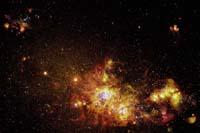How stars are created

So far, two theories on the formation of stars have been validated. However, a group of American astronomers have found evidence to rule out one of the two theories -- the credit-model -- and other data reinforcing the other -- the gravitational collapse.
For a long time, astronomers have been discussing between the two theories mentioned. The model of gravitational collapse indicates that stars are formed when molecular clouds, hundreds of times heavier than the Sun, are divided into gaseous nuclei, whose compaction is the origin of the stars. According to the model of accretion, in the molecular clouds the molecules are collected and collected to form bodies increasingly large to form the star.
Computer simulations have revealed that the augmentation model is too slow to explain the creation of stars. That is, the clouds of molecules survive too much to create a star. In addition, no star has been found to be emerging based on the rection model.
The model of gravitational collapse has also been studied by simulation. One of the consequences of these simulations is that the different types of stars have the same origin. This clearly explains why the mass distribution of newly created stars is constant in our galaxy and other galaxies.
Once again, the increasingly refined computer simulations have served to help scientists.
Buletina
Bidali zure helbide elektronikoa eta jaso asteroko buletina zure sarrera-ontzian











